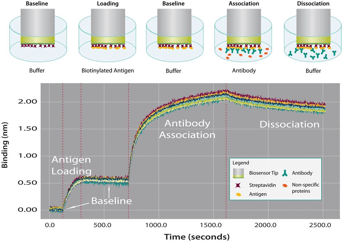
High-performance liquid chromatography (HPLC) has been used as the gold standard for antibody quantitation and purification for the past 50 years. This chromatographic technique is widely used in analytical chemistry and biochemistry to identify and quantify the compounds within a mixture. This process is also useful in antibody development processes and helps in identifying nonaggregate antibodies in solution. The major limitation of HPLC quantitation is that it requires a long time for analysis and the cost is generally exceedingly high as compared to other available methods. Another drawback is its inability to derive binding kinetics to determine antibody performance, i.e., affinity and dissociation constants.
With the invention of biolayer interferometry and its commercialization by ForteBio with the Octet instrument in 2005, there is now a more accurate method of measuring antibody and protein concentration. This method can also be done at a low cost per assay in contrast to other quantitation processes, including HPLC.
Overview of Octet Protein Quantitation:
The Octet analysis system introduced by ForteBio is a label-free detection system that enables real-time analysis of biomolecular interactions. The instrument incorporates sensors coated with specific probes used for the capture and detection of specific biomolecules. This is incredibly useful for measuring the concentration of important biomolecules, such as developing a quantitation assay for monoclonal antibodies. The sensors can be customized with different probes for the quantitation of recombinant proteins or therapeutics, etc. The system has a high level of accuracy, throughput rate and can predict performance by calculating kinetic properties even in complex matrices.
Utilizing this method has increased Green Mountain Antibodies production capability and improved antibody production by monitoring developing cell lines. Companies that incorporate the Octet quantitation procedure can create unique innovative products consistently.
How Does an Octet System Works?
Octet systems utilize bio-layer interferometry (BLI) optical technology that takes advantage of the interference of bound biomolecules on the light path passing through the sensor. With the help of BLI, the probes are dipped into samples and the changes in the light path can be measured in real-time.
A standard curve is generated using known amounts of antibodies while the unknown sample concentrations are extrapolated from the standard curve. The concentration of the antibodies is then assessed with the direct binding assay reliably and reproducibly. This is a homogenous assay with no wash steps making the entire assay time shorter and less costly.
Benefits of Using Octet Protein Quantitation:
Based on Bio-Layer Interferometry (BLI), this fluidics-free instrument platform offers several advantages over traditional label-free techniques that require fluidics, i.e., HPLC. Some benefits of the octet system include the following:
- Higher Handling Capacity: Octet HTX system has improved productivity rate. The system can perform protein quantitation in less than two minutes on a maximum of 96 samples.
- Offer Faster Manipulation: Octet system uses wavelength (nm) shift to predict any surface changes completing the measurement process effectively at a much faster rate.
- The System Is Economical: The major advantage of this system is the low maintenance cost. No fluidics clogs or failed pumps causing downtime while waiting for replacements are some hidden costs of other systems.
Why Converting an ELISA into An Octet Protein Quantitation Assay Is Better?
The Octet platform has overcome the limitations of ELISA. An enzyme-linked immunosorbent assay (ELISA) requires a capture antibody and detection antibody to create a “sandwich” with the biomolecule of interest in the middle. The detection antibody is labeled and requires another step to detect the presence of the label which correlates to the quantity of the biomolecule of interest.
The ELISA requires several wash steps and incubation steps to complete the assay and measure the biomolecules. Therefore, there are several variables that must be accounted for when developing an ELISA kit.
With the superfast and precise Octet system, it is possible to create a direct measurement. The probe on the Octet HTX can be dipped into a sample and measurements can be made without any further steps. The decisions can be made earlier in both drug and process development which is an incredible advantage when time is a factor.
In summary, the Octet platform has an overall advantage in terms of time, effort, and cost as compared to ELISA and HLPC. The Octet platform is much more reliable, expedient, and cost-effective.
Develop Monoclonal Antibodies Using Octet Analysis:
Green Mountain Antibodies utilizes an Octet analysis system for developing monoclonal antibodies which help us deliver protein quantitation with a higher level of accuracy and produce results quickly and efficiently.
Contact Green Mountain Antibodies for a full range of services for creating new monoclonal antibodies at 802-865-6230.






